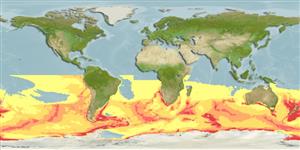Common names from other countries
Classification / Names / Names
Namen | Synonyme | Catalog of Fishes (gen., sp.) | ITIS | CoL | WoRMS
Environment: milieu / climate zone / depth range / distribution range
Ökologie
Bathydemersal. Polar; 0°N - 90°S, 180°W - 180°E
Indo-Pacific, Atlantic Ocean, and the Antarctic.
Length at first maturity / Size / Gewicht / Alter
Maturity: Lm ? range ? - ? cm Max length : 300 cm TL Männchen/unbestimmt; (Ref. 1394); 360 cm TL (female); max. veröff. Gewicht: 450.0 kg (Ref. 1394); max. veröff. Gewicht: 450.0 kg
Found throughout the pack ice zone; haul out on ice and land, often preferring ice floes, when available. Feeds on krill, fish, squid, penguins, and young seals, and will occasionally scavenge from carcasses of whales (Ref. 1394). Found throughout the pack ice zone; haul out on ice and land, often preferring ice floes, when available. Feeds on krill, fish, squid, penguins, and young seals, and will occasionally scavenge from carcasses of whales (Ref. 1394).
Jefferson, T.A., S. Leatherwood and M.A. Webber. 1993. (Ref. 1394)
IUCN Rote Liste Status (Ref. 130435)
CITES Status (Ref. 108899)
Not Evaluated
Not Evaluated
Nutzung durch Menschen
Fischereien: kommerziell
FAO - Fischereien: Artbeschreibung | FishSource | Sea Around Us
Tools
Mehr Information
NamenSynonymeRäuberFortpflanzungGeschlechtsreifeAblaichenFecundityEierEientwicklung
Internet Quellen
Estimates based on models
Preferred temperature
(Ref.
115969): -1.9 - 1.4, mean -0.5 (based on 2109 cells).
Widerstandsfähigkeit
hoch, Verdopplung der Population dauert weniger als 15 Monate. (K=0.36-0.47).
Verwundbarkeit
Very high vulnerability (90 of 100).
Preiskategorie
Unknown.
